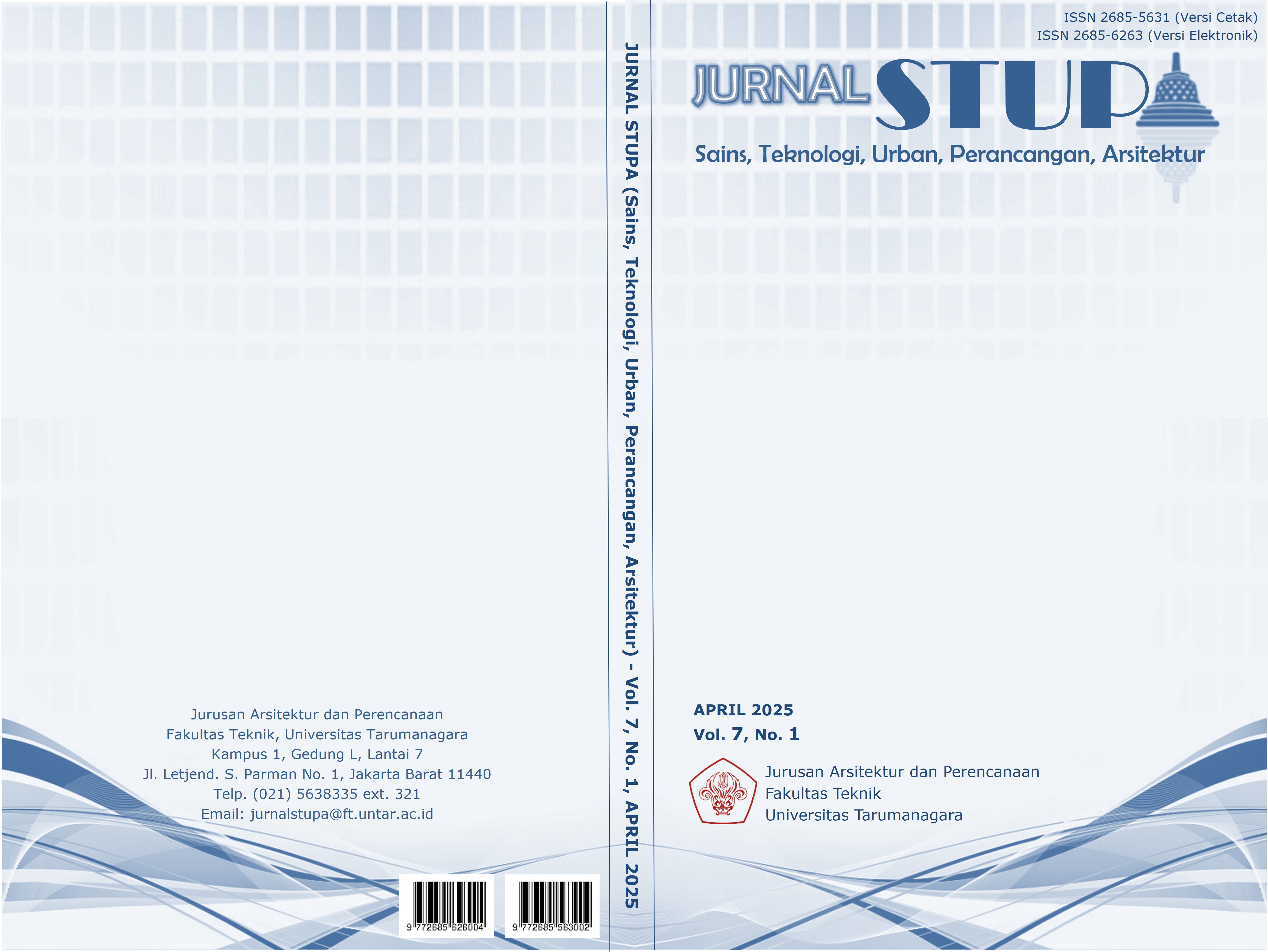TRANSFORMASI GRAND THEATER SENEN: PENDEKATAN DESAIN FLEKSIBEL ADAPTIF DALAM MENCIPTAKAN RUANG MULTIFUNGSI
Main Article Content
Abstract
The development of technology and time has pushed many things to be better, but there are also some things that must be left behind. This forms the phenomenon of the abandonment of old buildings because they have fallen behind the times and have begun to be forgotten, one of which is the Grand Theater Senen. The issue began with the emergence of more modern cinema business competitors, coupled with the absence of maintenance and renewal of the building so that this building was widely used by the community for negative activities such as pickpocketing, the spread of narcotics, and prostitution. Until finally this building experienced functional degradation and lost its identity. In essence, Grand Theater Senen has a strategic location, located in the middle of the intersection of five very busy main roads. Coupled with the proximity of the site to the Transjakarta bus stop and Senen Station. With the high activity of the area that is classified as high raises the problem of abandoned buildings in the middle of the Senen Market Area, its proximity to the untidy market makes the image of the Senen Market Area dirty and shabby. From the problems that arise, space is needed that can be used by the community by feeling ownership of the building and can be adjusted to the needs of visitor activities. The research step was carried out by conducting a study related to the Grand Theater Senen building within the last five years, then continued with direct observation for mapping related to potential points around the site, and continued with the design of the building program, the program includes community space, culinary, offices, museums and galleries. The application of the flexibility concept aims to provide space to visitors that can be adjusted to the needs of activities for the sustainability of the building.
Keywords: degradation; flexibility; history of Grand Theatre Senen
Abstrak
Perkembangan teknologi dan zaman telah mendorong banyak hal menjadi lebih baik, namun ada beberapa hal juga yang harus tertinggal. Hal ini membentuk fenomena tertinggalnya bangunan tua karena sudah tertinggal zaman dan sudah mulai dilupakan, salah satunya adalah Grand Theater Senen. Isunya dimulai dengan munculnya pesaing bisnis bioskop yang lebih modern, ditambah dengan tidak adanya perawatan maupun pembaruan pada bangunannya sehingga bangunan ini banyak digunakan masyarakat untuk aktivitas negatif seperti pencopetan, penyebaran narkotika, dan prostitusi. Hingga akhirnya bangunan ini mengalami degradasi fungsi dan kehilangan identitasnya. Pada hakikatnya Grand Theater Senen memiliki lokasi yang strategis, letaknya berada di tengah persimpangan lima jalanan utama yang sangat ramai. Ditambah lagi dengan dekatnya tapak dengan halte Transjakarta dan Stasiun Senen. Dengan ramainya aktivitas kawasan yang tergolong tinggi memunculkan masalah adanya bangunan terbengkalai di tengah kawasan Pasar Senen, kedekatannya dengan tidak rapinya pasar membuat citra kawasan Pasar Senen menjadi kotor dan kumuh. Dari permasalahan yang muncul dibutuhkan ruang yang dapat digunakan oleh masyarakat dengan merasakan kepemilikan terhadap bangunan dan dapat disesuaikan dengan kebutuhan aktivitas pengunjungnya. Langkah penelitian dilakukan dengan melakukan kajian terkait bangunan Grand Theater Senen dalam kurun waktu lima tahun terakhir, kemudian dilanjutkan dengan observasi secara langsung untuk mapping terkait titik potensi yang ada di sekitar tapak, dan dilanjutkan dengan perancangan program bangunan, program tersebut meliputi community space, kuliner, perkantoran, museum dan galeri. Penerapan konsep fleksibilitas bertujuan untuk memberikan ruang kepada pengunjung yang dapat disesuaikan dengan kebutuhan aktivitas untuk keberlanjutan bangunan.
Article Details

This work is licensed under a Creative Commons Attribution-NonCommercial-ShareAlike 4.0 International License.
This work is licensed under a Jurnal Sains, Teknologi, Urban, Perancangan, Arsitektur/ STUPA Creative Commons Attribution-NonCommercial-ShareAlike 4.0 International LicenseReferences
Ferissa, A. (2018). PASAR SENEN : REORGANISASI PASAR TAHUN 1966-1993. 2(1), 86-100. doi:https://doi.org/10.15575/hm.v2i1.9672
Marcella, V., & Trisno, R. (2022, October). SENEN ART HUB: MENGEMBALIKAN CITRA PUSAT HIBURAN DI KAWASAN SENEN. JURNAL STUPA, 4(2), 699-710. doi:10.24912/stupa.v4i2.21707
Marnisari, J. A., & Winasih, S. S. (2022, September). PENERAPANKONSEP FLEKSIBILITAS ARSITEKTUR DALAMPERENCANAANPUSATINDUSTRI KREATIFDI SIDOARJO. SYNTAX LITERATE: JURNAL ILMIAH INDONESIA, 7(9), 15682-15694. doi:https://doi.org/10.36418/syntax-literate.v7i9.14739
Marzo, L. C., & Devine-Wright, P. (2014). PLACE ATTACHMENT: ADVANCES IN THEORY, METHODS, AND APPLICATIONS.
Mirzani, S., Sudarwani, M., & Eni, S. P. (2023, June). ARCHITECTURAL CHARACTER ANALYSIS OF SENEN AREA, CENTRAL JAKARTA. International Journal of Innovative Science and Research Technology, 8(6), 1100-1119. Diambil kembali dari http://repository.uki.ac.id/id/eprint/11859
Pratama, R. S., & Gandha, M. V. (2022, October). SENEN HALL: REVITALISASI GEDUNG GRAND THEATER SNEN. JURNAL STUPA, 4(2), 793-806. doi:10.24912/stupa.v4i2.21714
Rapoport, A. (2005). CULTURE, ARCHITECTURE, DESIGN. English.
Relph, E. (1976). PLACE AND PLACELESSNESS.
Saputra, M. R., & Purwantiasning, A. W. (2020). KAJIAN ADAPTIVE REUSE PADA BANGUNAN DI KOTA TUA JAKARTA. 4(1), 47-52. doi:https://doi.org/10.24853/purwarupa.4.1.47-52
Tadié, J. (2022, Feb 1). THE HIDDEN TERRITORIES OF JAKARTA. HAL Open Science, 1-15. Diambil kembali dari https://shs.hal.science/halshs-01453146/
Tuan, Y. F. (1977). SPACE AND PLACE: THE PERSPECTIVE OF EXPERIENCE.
Yusuf, N. F. (2023, Januari). PASARSENEN: DARI PASAR MENJADI KAWASAN ELIT. Jurnal Historia Universitas Jember, 6(1), 17-26. Diambil kembali dari https://jurnal.unej.ac.id/index.php/JH



